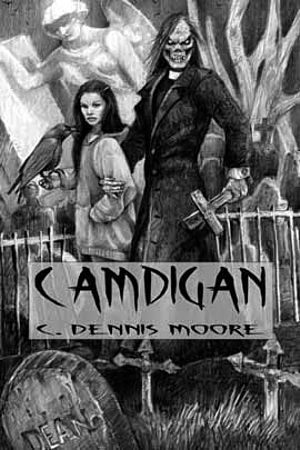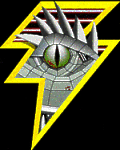 |
 |
Review by Michael T. Huyck Jr. |
 CAMDIGAN - 2004 CAMDIGAN - 2004By C. Dennis Moore USA Release: May 15, 2004 Published by Scrybe Press CB ISBN 978-0-974-83403-0 |
||
Within the Christian mythos there's your basic Heaven and your basic Hell. Some churches within the Christian fold embellish a tad, throwing in sundry purgatories and oddly named substrata between the polar opposites. And it's there that we find CAMDIGAN.
Camdigan is … well, somewhere else.
Somewhere not between Kansas City and Seattle, the outbound and inbound points our protagonist believes he's traveling between. David Tierny is a recently employed guitar teacher who's driving to Seattle from KC to start his new job. He finds himself, after the ubiquitous wrong turn, idling his car about the streets of the cold, gray city. That he got turned around isn't hard to believe, as he'd been attempting the 2,800+ mile drive straight through without breaking to rest anywhere in-between. As you might guess, there are plenty of white and yellow lines between KC and Seattle. Or KC and Camdigan, if you will, being as that's where he turns up.
If you think about it, "cold and gray" is a strange way to honestly describe a town. It can't all be gray, not with the grass and trees and such. So you start off not knowing anything even normal about this place. Everything is done in shades of gray just because … it is. The same goes for the cold. It's not necessarily winter, nor is there a Nor'easter blowing. There's just a chill, like that of a tiled hospital hallway after midnight: Sans the echo, of course.
It's a strange "cold and gray."
Also strange about this town is its reluctant and unfriendly inhabitants. At the novella's start David watches a large procession of cars (yes - of course - black cars) moving quickly down a street. Automatically it fits that this should be a funeral procession, and David is uncomfortable with following them to ask for directions out of town. Still, worse than interrupting the funeral of someone you don't know is missing your first day of work at a new job. So David follows the cars, all the way to a large church, intent on asking directions towards Seattle.
To a HUGE church. An enormous church. A slab-sided, angel-topped, quad-steepled church. And what color would you guess the church is?
Very good. You're catching on. Of course, we're both guessing now because the author didn't tell us what color the church was. I just wanted to see if you were paying attention.
At the church David sees two things that turn out to be very important. The first is a girl, a girl he'd seen earlier as he'd just entered town. He tried to speak to her then, and she'd ran. Here she was again, a young girl looking altogether too much like someone David had loved and lost over a decade before. A spitting image even, except that this young girl was still a young girl.
The second thing David sees is that this isn't a burial. Nor is it a standard looking church-ish ceremony. No, what he finds is a huge crowd of folk watching a guy in a gray robe pull a dripping lump of pink flesh out of a large stone tub of water. Perhaps a baptism?
It's time, dear reader, to stop feeding you the story in little bites. Instead, let's study CAMDIGAN as a whole.
As we go along we learn that Camdigan is not a real city; it's some land between Heaven and Hell where one spends time before they get their turn to head down Halo Street.
Some questions? Why and/or how does one end up in Camdigan? Besides taking a wrong turn, of course. And where does this Halo Street go? Finally, just why would we want to go there? This place where David never sees anyone eat and can't remember anyone walking on the sidewalks. This place where there seems to be only one church … the Church of the Pink Lump. And why is everyone's car black?
 Author, C. Dennis Moore's writing is clean and clear. He doesn't unnecessarily
clutter up his sentences with fat metaphors and graphic descriptions that
don't advance the story. Since I'm a fan of spare writing, I appreciate
his style. His David Tierney character, reacts adequately stupefied to
the situation at hand. I say only adequately because
Author, C. Dennis Moore's writing is clean and clear. He doesn't unnecessarily
clutter up his sentences with fat metaphors and graphic descriptions that
don't advance the story. Since I'm a fan of spare writing, I appreciate
his style. His David Tierney character, reacts adequately stupefied to
the situation at hand. I say only adequately because
a) no one really knows how someone would react when found surrounded by
something so supernatural and unthinkable, and
b) therefore everyone judges the character's response against what they
perceive their own response would be in the same situation.
I think, if I could keep from going instantly apeshit nuts, I'd react like David. The character who has the appearances of a twelve-year-old girl but really isn't one, works for me. She's very brave at points, but then again she's been in Camdigan for a dozen years and much of what's strange to David is just home to her. As for the ending, well, I saw only a few satisfactory ways to bring this story to fold, and Mr. Moore chose one of those.
A couple points: David takes on a very sensitive subject that, while it fit and was done with taste, wasn't necessary. I don't know that I would have chosen to alienate the few readers he's bound to disaffect when they read the section in question. Those are my light gray reactions. Now for my dark gray one.
Towards the story's end we learn more about what Camdigan really is. But we don't learn enough. There's at least one way that David should have known the true Camdigan. The one you'll know when you turn that last page.
This isn't a fatal flaw, by any means. In fact, I didn't notice it until my third or fourth reading. No, I highly recommend CAMDIGAN and should get your own copy.
Now.
I haven't had the opportunity to see a paper copy, but the cover art displayed at the Scrybe Press page is gorgeous.
4 BookWyrms




This review copyright 2005 E.C.McMullen Jr.
| DRESS NICE | |
| FEO AMANTE'S HORROR THRILLER Created by: E.C.MULLEN JR. |
| COME FOLLOW ME @ Amazon |
| ECMJr |
| Feo Blog |
| IMDb |
| Stage32 |
| YouTube |
| Zazzle Shop |

